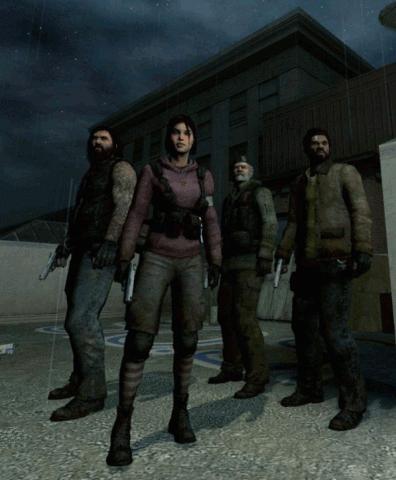Left 4 Dead is a FPS with a strong coop mode, that was developed by Turtle Rock Studios and published by Valve for PC Windows and the Xbox 360 in 2008. The Left 4 Dead beta characters were changed, and at the Electronic Arts E3 2008 press conference, Valve revealed a new characters design for the survivors. As we can read on Wikipedia, Left 4 Dead underwent many phases of development; influenced by playtesting, Turtle Rock Studios removed many of the features that were originally in the game. Another significant element removed was a long introduction between campaigns; because the game is designed for replayability, it was difficult to hold the player’s attention for repeated viewings of cut scenes, so they were dropped in favor of a sparse narrative.
Also, the game started out with one big city design with many routes for the survivors, but playtesters were confused when they began to play, and later they always chose the same route; ultimately Turtle Rock Studios cut the city maps into the first “No Mercy” and “Dead Air” campaigns.
Here’s a comparison between the old characters (top) and the new ones (below):

As Nastykill has made us to notice, at the Official L4D Blog we can find a lot of interesting infos and screens / videos from the game development, like the early experiments with the lights in the backgrounds and some test cutscenes. Some more screenshots from an early build show the beta characterts and a couple of beta areas.
At Left 4 Dead Wikia we can read a lot of info about the game’s development.
Upgrades are a scrapped feature that can still be found hidden in the game’s code, but they can only be activated by using an hack command. Some of these upgrades are:
- Kevlar Vest: This item reduces the amount of damage you take.
- Prevent it: Protects you from a Boomer’s bile once.
- Hot Meal: Increases current health to 150.
- High capacity magazine: Gives the player a larger magazine with each of their weapons, though the exact percentage increase is unknown.
- Hollow point ammo: Increases the amount of damage weapons do.
A small upgrade system is implemented in Left 4 Dead 2, including the Laser Sight originally meant for Left 4 Dead.
Originally the melee weapons were supposed to break after prolonged use, but the development team ultimately decided against it after testing. Break sounds for the Axe and Frying Pan weapons can still be found in the game files.
The Hunter has an unused animation of it hanging upside-down. The Hunter’s ability was originally to become invisible. It did this when backed up against a wall, then the pounce ability can be used. For some reason, it was cut to just leaping, possibly due to that Left 4 Dead tries to keep a realistic theme, and an invisible Infected may have simply been too far-fetched. It also could regenerate, but was cut along with the invisibility.
The original design of the Smoker was to “pop in” to the Survivor group in a cloud of smoke, seize any Survivor, and “pop out” again to leave the unlucky Survivor stranded. Valve changed the design, however, saying it was “too challenging for the players.” This design has never been seen in any video footage, suggesting that it was dropped early in development.
A later video shows that the player took something called “poison damage” from a Smoker. When a person was affected by poison damage, the damage inflicted would turn into temporary health.
The Screamer was a Special Infected in the early stage of game development, preceding the Witch and the Boomer’s vomit attack. The Screamer did not have any actual attacks: if agitated enough, it would run off to hide. Once hidden, it would let out a scream, attracting a horde, like the Boomer’s bile. It was therefore important to kill the Screamer as quickly as possible while it tried to run off.
Originally, the Witch was to attack the entire group upon being startled. However, this was cut from the final game because it was deemed too difficult as she would often wipe out the whole group with little trouble.
Originally, Valve intended Zoey and Francis to have a relationship, but this was deemed to be “distracting” by the play-testers. In her cut quotes, Zoey picks on him often [3]. Although their former relationship is no longer very evident, she still seems to be friendly towards him (“Groovy,” which was something he’d said before). In The Passing, she’s baffled by Rochelle showing an attraction to Francis, and claims she’s going to throw up. On the other hand, she finds it cute that Francis still has “that side of him” deep down despite his tough guy attitude when he flirts with Rochelle.
Thanks to DCodes7 and Ace.Dark for the contributions!
Images:
Videos:









